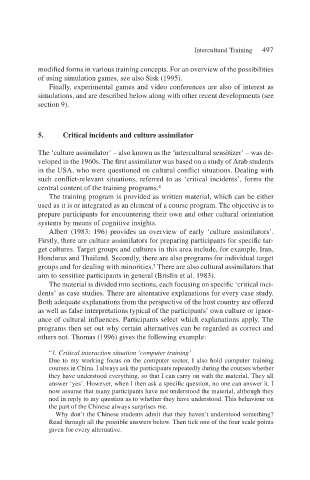Page 519 - Handbooks of Applied Linguistics Communication Competence Language and Communication Problems Practical Solutions
P. 519
Intercultural Training 497
modified forms in various training concepts. For an overview of the possibilities
of using simulation games, see also Sisk (1995).
Finally, experimental games and video conferences are also of interest as
simulations, and are described below along with other recent developments (see
section 9).
5. Critical incidents and culture assimilator
The ‘culture assimilator’ – also known as the ‘intercultural sensitizer’ – was de-
veloped in the 1960s. The first assimilator was based on a study of Arab students
in the USA, who were questioned on cultural conflict situations. Dealing with
such conflict-relevant situations, referred to as ‘critical incidents’, forms the
central content of the training programs. 4
The training program is provided as written material, which can be either
used as it is or integrated as an element of a course program. The objective is to
prepare participants for encountering their own and other cultural orientation
systems by means of cognitive insights.
Albert (1983: 196) provides an overview of early ‘culture assimilators’.
Firstly, there are culture assimilators for preparing participants for specific tar-
get cultures. Target groups and cultures in this area include, for example, Iran,
Honduras and Thailand. Secondly, there are also programs for individual target
5
groups and for dealing with minorities. There are also cultural assimilators that
aim to sensitize participants in general (Brislin et al. 1983).
The material is divided into sections, each focusing on specific ‘critical inci-
dents’ as case studies. There are alternative explanations for every case study.
Both adequate explanations from the perspective of the host country are offered
as well as false interpretations typical of the participants’ own culture or ignor-
ance of cultural influences. Participants select which explanations apply. The
programs then set out why certain alternatives can be regarded as correct and
others not. Thomas (1996) gives the following example:
“1. Critical interaction situation ‘computer training’
Due to my working focus on the computer sector, I also hold computer training
courses in China. I always ask the participants repeatedly during the courses whether
they have understood everything, so that I can carry on with the material. They all
answer ‘yes’. However, when I then ask a specific question, no one can answer it. I
now assume that many participants have not understood the material, although they
nod in reply to my question as to whether they have understood. This behaviour on
the part of the Chinese always surprises me.
Why don’t the Chinese students admit that they haven’t understood something?
Read through all the possible answers below. Then tick one of the four scale points
given for every alternative.

